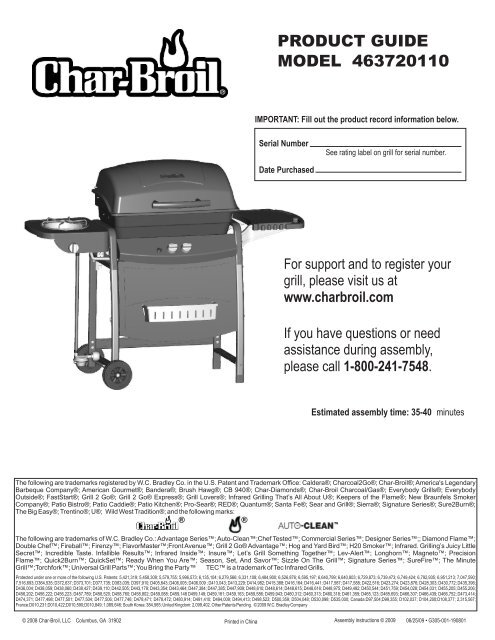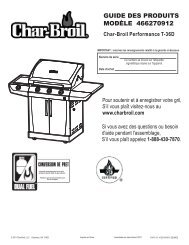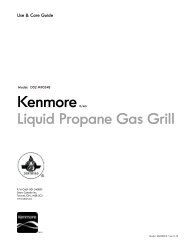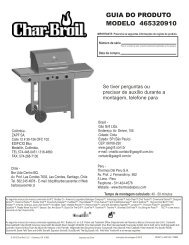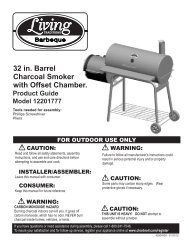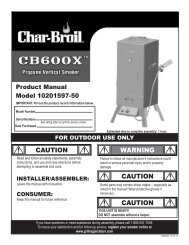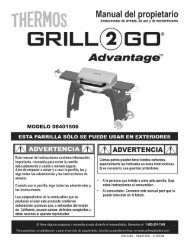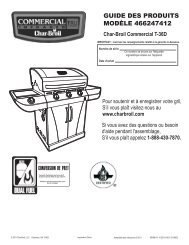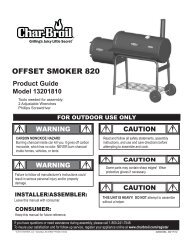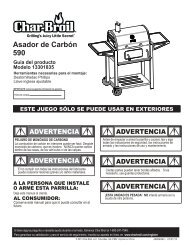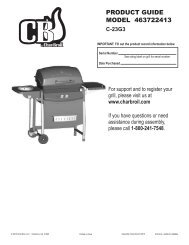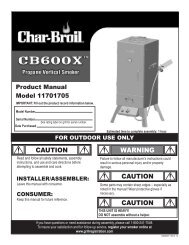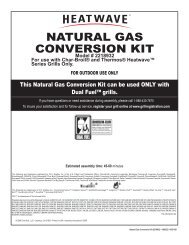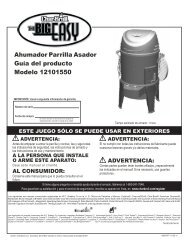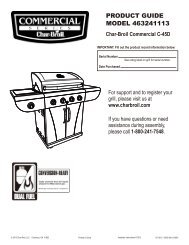product guide model 463720110 - Char-Broil Grills
product guide model 463720110 - Char-Broil Grills
product guide model 463720110 - Char-Broil Grills
Create successful ePaper yourself
Turn your PDF publications into a flip-book with our unique Google optimized e-Paper software.
PRODUCT GUIDE<br />
MODEL <strong>463720110</strong><br />
IMPORTANT: Fill out the <strong>product</strong> record information below.<br />
Serial Number<br />
See rating label on grill for serial number.<br />
Date Purchased<br />
For support and to register your<br />
grill, please visit us at<br />
www.charbroil.com<br />
If you have questions or need<br />
assistance during assembly,<br />
please call 1-800-241-7548.<br />
Estimated assembly time: 35-40 minutes<br />
The following are trademarks registered by W.C. Bradley Co. in the U.S. Patent and Trademark Office: Caldera®; <strong>Char</strong>coal2Go®; <strong>Char</strong>-<strong>Broil</strong>®; America's Legendary<br />
Barbeque Company®; American Gourmet®; Bandera®; Brush Hawg®; CB 940®; <strong>Char</strong>-Diamonds®; <strong>Char</strong>-<strong>Broil</strong> <strong>Char</strong>coal/Gas®; Everybody <strong>Grills</strong>®; Everybody<br />
Outside®; FastStart®; Grill 2 Go®; Grill 2 Go® Express®; Grill Lovers®; Infrared Grilling That’s All About U®; Keepers of the Flame®; New Braunfels Smoker<br />
Company®; Patio Bistro®; Patio Caddie®; Patio Kitchen®; Pro-Sear®; RED®; Quantum®; Santa Fe®; Sear and Grill®; Sierra®; Signature Series®; Sure2Burn®;<br />
The Big Easy®; Trentino®; U®; Wild West Tradition®; and the following marks:<br />
® ®<br />
The following are trademarks of W.C. Bradley Co.: Advantage Series; Auto-Clean;Chef Tested; Commercial Series; Designer Series;; Diamond Flame;<br />
Double Chef; Fireball; Firenzy; FlavorMaster;Front Avenue; Grill 2 Go® Advantage; Hog and Yard Bird; H20 Smoker; Infrared. Grilling’s Juicy Little<br />
Secret; Incredible Taste. Infallible Results; Infrared Inside; Insure; Let’s Grill Something Together; Lev-Alert; Longhorn; Magneto; Precision<br />
Flame; Quick2Burn; QuickSet; Ready When You Are; Season, Set, And Savor; Sizzle On The Grill; Signature Series; SureFire; The Minute<br />
Grill;Torchfork; Universal Grill Parts; You Bring the Party TEC is a trademark of Tec Infrared <strong>Grills</strong>.<br />
Protected under one or more of the following U.S. Patents: 5,421,319; 5,458,309; 5,579,755; 5,996,573; 6,135,104; 6,279,566; 6,331,108; 6,484,900; 6,526,876; 6,595,197; 6,640,799; 6,640,803; 6,729,873; 6,739,473; 6,749,424; 6,792,935; 6,951,213; 7,047,590;<br />
7,516,693; D364,535; D372,637; D373,701; D377,735; D383,035; D397,910; D405,643; D406,005; D406,009 ; D413,043; D413,229; D414,982; D415,388; D416,164; D416,441; D417,587; D417,588; D422,516; D423,274; D423,876; D428,303; D430,772; D435,396;<br />
D436,004; D438,059; D438,060; D438,427; D439,110; D442,505; D443,179; D443,354; D443,464; D447,384; D447,385; D447,909; D448,610; D448,614; D448,615; D448,616; D448,975; D449,492; D450,544; D451,759; D454,028; D454,031; D455,205; D455,206;<br />
D456,202; D456,222; D456,223; D457,789; D458,520; D458,760; D458,802; D459,088; D459,148 D459,149; D459,161; D459,163; D459,586; D459,943; D460,312; D460,313; D460,318; D461,359; D465,123; D465,693; D466,307; D466,439; D466,752; D473,414;<br />
D474,371; D477,498; D477,501; D477,504; D477,506; D477,746; D478,471; D478,472; D480,914; D491,410; D494,009; D494,413; D498,523; D500,359; D504,048; D530,098; D535,000; Canada:D97,504;D99,355; D102,037; D104,200;D108,377; 2,315,567;<br />
France:D010,231;D010,422;D010,590;D010,849; 1,089,646; South Korea: 384,565; United Kingdom: 2,099,402. Other Patents Pending. © 2009 W.C. Bradley Company<br />
© 2008 <strong>Char</strong>-<strong>Broil</strong>, LLC Columbus, GA 31902 Printed in China<br />
Assembly instructions © 2009<br />
06/25/09 • G305-001-190801
TABLE OF CONTENTS<br />
For Your Safety . . . . . . . . . . . . . . . . . . . . . . . . . . . . . . . . . . . . 2-3<br />
Grilling Guide. . . . . . . . . . . . . . . . . . . . . . . . . . . . . . . . . . . . . . 4-7<br />
Use and Care . . . . . . . . . . . . . . . . . . . . . . . . . . . . . . . . . . . . 8-13<br />
Limited Warranty. . . . . . . . . . . . . . . . . . . . . . . . . . . . . . . . . . . . 14<br />
Parts List. . . . . . . . . . . . . . . . . . . . . . . . . . . . . . . . . . . . . . . . . . 15<br />
Parts Diagram. . . . . . . . . . . . . . . . . . . . . . . . . . . . . . . . . . . . . . 16<br />
Assembly . . . . . . . . . . . . . . . . . . . . . . . . . . . . . . . . . . . . . . . 17-27<br />
Troubleshooting. . . . . . . . . . . . . . . . . . . . . . . . . . . . . . . . . . 28-29<br />
Registration Card . . . . . . . . . . . . . . . . . . . . . . . . . . . . . . . . . . . 31<br />
Safety Symbols<br />
The symbols and boxes shown below explain what each heading<br />
means. Read and follow all of the messages found throughout<br />
the manual.<br />
WARNING<br />
WARNING: Indicates an potentially hazardous situation<br />
which, if not avoided, could result in death or serious injury.<br />
CAUTION<br />
CAUTION: Indicates a potentially hazardous situation or<br />
unsafe practice which, if not avoided, may result in minor<br />
or moderate injury.<br />
DANGER<br />
DANGER: Indicates an imminently hazardous situation<br />
which, if not avoided, will result in death or serious injury.<br />
If you smell gas:<br />
DANGER<br />
1. Shut off gas to the appliance.<br />
2. Extinguish any open flame.<br />
3. Open lid.<br />
4. If odor continues, keep away from the<br />
appliance and immediately call your gas<br />
supplier or your fire department.<br />
WARNING<br />
1. Do not store or use gasoline or other<br />
flammable liquids or vapors in the vicinity of<br />
this or any other appliance.<br />
2. An LP cylinder not connected for use shall not<br />
be stored in the vicinity of this or any other<br />
appliance.<br />
CAUTION<br />
For residential use only. Do not use for commercial<br />
cooking.<br />
THIS GRILL IS FOR OUTDOOR USE ONLY.<br />
CAUTION:<br />
Read and follow all safety statements, assembly<br />
instructions, and use and care directions before attempting<br />
to assemble and cook.<br />
INSTALLER/ASSEMBLER:<br />
Leave this manual with consumer.<br />
CONSUMER:<br />
Keep this manual for future reference.<br />
WARNING:<br />
Failure to follow all manufacturer’s instructions could result<br />
in serious personal injury and/or property damage.<br />
CAUTION:<br />
Some parts may contain sharp edges – especially as noted<br />
in the manual! Wear protective gloves if necessary.<br />
2
WARNING<br />
CALIFORNIA PROPOSITION 65<br />
1. Combustion by-<strong>product</strong>s produced when using<br />
this <strong>product</strong> contain chemicals known to the State of<br />
California to cause cancer, birth defects, and other<br />
re<strong>product</strong>ive harm.<br />
2. This <strong>product</strong> contains chemicals, including lead<br />
and lead compounds, known to the State of<br />
California to cause cancer, birth defects or other<br />
re<strong>product</strong>ive harm.<br />
Wash your hands after handling this <strong>product</strong>.<br />
CAUTION<br />
Using pots larger than 6 quarts in capacity could<br />
exceed weight limit of the<br />
side burner shelf<br />
or side shelf,<br />
resulting in failure<br />
of grill cart<br />
components.<br />
Installation Safety Precautions<br />
• Use grill, as purchased, only with LP (propane) gas and the<br />
regulator/valve assembly supplied. A conversion kit for dual fuel<br />
grills must be purchased for use with natural gas.<br />
• Grill installation must conform with local codes, or in their<br />
absence of local codes, with either the National Fuel Gas<br />
Code, ANSI Z223.1/ NFPA 54, Natural Gas and Propane<br />
Installation Code, CSA B149.1, or Propane Storage and<br />
Handling Code, B149.2, or the Standard for Recreational<br />
Vehicles, ANSI A 119.2/NFPA 1192, and CSA Z240 RV Series,<br />
Recreational Vehicle Code, as applicable.<br />
• All electrical accessories (such as rotisserie) must be<br />
electrically grounded in accordance with local codes, or<br />
National Electrical Code, ANSI / NFPA 70 or Canadian<br />
Electrical Code, CSA C22.1. Keep any electrical cords and/or<br />
fuel supply hoses away from any hot surfaces.<br />
• This grill is safety certified for use in the United States and/or<br />
Canada only. Do not modify for use in any other location.<br />
Modification will result in a safety hazard.<br />
WARNING<br />
Do not attempt to repair or alter the<br />
hose/valve/regulator for any “assumed” defect. Any<br />
modification to this assembly will void your warranty<br />
and create the risk of a gas leak and fire. Use only<br />
authorized replacement parts supplied by<br />
manufacturer.<br />
3
GRILLING GUIDE – Getting Started<br />
First Time Use<br />
Read your Assembly Manual and ensure the grill is put together<br />
properly. Remove all Point-of-Purchase advertising material from<br />
all grill surfaces before first use. We recommend operating your<br />
grill on its highest setting for 15-20 minutes prior to your first use.<br />
This aids in removing the oils used during manufacturing.<br />
Lava Rock / Briquettes<br />
This gas grill has been designed, engineered, and tested to be<br />
used with flame tamers or heat distribution plates to provide<br />
more even heating, improve the cleaning process, and reduce<br />
flare-ups. The addition of after market lava rocks, charcoal, or<br />
briquettes of any type will cause poor combustion and increase<br />
the likelihood of a grease fire, and is not recommended. Using<br />
briquettes, lava rock, or charcoal in this grill will void your<br />
warranty. For extra smoke flavor, we recommend using a<br />
smoker box with wood chips.<br />
Temperature<br />
The temperature gauge in the hood of your new grill measures<br />
air temperature. The air temperature inside your grill will never<br />
be as hot as the temperature at the cooking surface.<br />
Note: Since 1995, all regulators (the part that attaches to the gas<br />
tank to regulate the flow of gas) have included a safety feature<br />
that restricts gas flow in the event of a gas leak. You can<br />
inadvertently activate this safety feature without having a gas<br />
leak. This typically occurs when you turn on the gas using the<br />
grill control knob before you turn on the LP tank valve. If the gas<br />
regulator safety feature activates, the grill will only reach<br />
temperatures between 250°F and 300°F even with all burners on<br />
the high setting.<br />
Regulator<br />
Coupling Nut<br />
If your grill is not getting hotter than 250°F to 300°F these<br />
steps should be taken first to reset the gas regulator safety<br />
device:<br />
1. Open the grill lid.<br />
2. Turn off all knobs on the control panel in front.<br />
3. Turn off the tank knob.<br />
4. Disconnect the regulator from the LP tank.<br />
5. Wait 30 seconds.<br />
6. Reconnect the regulator to the LP tank.<br />
7. Slowly open the LP tank knob all the way. Do not put<br />
excessive force on the valve at the full open position to avoid<br />
damaging the valve.<br />
8. Turn on the appropriate control knob and light the grill per the<br />
instructions on the control panel.<br />
An illustration of this process is included in this Product Guide.<br />
See Troubleshooting section for additional information.<br />
Pre-Heating Your Grill<br />
Just like your home oven, your grill should be pre-heated to<br />
provide optimum performance. Pre-heat the grill on high for 10-<br />
15 minutes – longer if weather conditions require. Please refer to<br />
the lighting instructions inside the Product Guide if you have<br />
questions about how to light your grill. A match-light chain and<br />
hole is provided for your convenience.<br />
4
GRILLING GUIDE – Grilling 101<br />
Outdoor grilling is really quite simple. You'll succeed with<br />
burgers, dogs, or steaks usually on your very first try. With<br />
experience, you will learn how to work with your grill, creating<br />
more imaginative meals all the time. This knowledge makes up<br />
the art of grilling. Before you start grilling, organize your food<br />
according to cooking technique and required cooking time, and<br />
optimize the use of your grilling area.<br />
Rotisserie Cooking<br />
Rotisserie cooking is best for 'round' meat, such as large roasts,<br />
whole poultry, and pork. It generally requires an accessory motor<br />
and spit rod that allows the meat to be turned at a constant<br />
speed. Rotisserie cooking is best done in front of a special<br />
rotisserie burner, or utilizing an indirect cooking burner<br />
arrangement. A pan can be placed underneath the meat to catch<br />
grease and food drippings, and helps minimize clean-up.<br />
Direct Cooking<br />
Direct cooking involves grilling your meat directly over high heat.<br />
It is perfect for searing steaks, chops, and other smaller pieces of<br />
meat and vegetables that quickly make their way to the table.<br />
Indirect Cooking<br />
Indirect cooking utilizes select burners to circulate heat<br />
throughout the grill, without direct contact between the meat and<br />
the flame. The meat is placed over the burner that is 'off'. This<br />
method is generally used to slow cook large cuts of meat and<br />
poultry. A pan can be placed underneath the meat to catch<br />
grease and food drippings, and helps minimize clean-up.<br />
Food Safety<br />
Food safety is a very important part of enjoying the outdoor<br />
cooking experience. To keep food safe from harmful bacteria,<br />
follow these four basic steps:<br />
Clean: Wash hands, utensils, and surfaces with hot soapy water<br />
before and after handling raw meat.<br />
Separate: Separate raw meats from ready-to-eat foods to avoid<br />
cross contamination. Use a clean platter and utensils when<br />
removing cooked foods.<br />
Cook: Cook meat and poultry thoroughly to kill bacteria. Use a<br />
thermometer to ensure proper internal food temperatures.<br />
Chill: Refrigerate prepared foods and leftovers promptly.<br />
5
GRILLING GUIDE – Tips & Tricks<br />
Cooking on your new grill is a hands-on experience, and it is<br />
recommended to remain outside with your grill while cooking.<br />
Grilling can be affected by many external conditions. In cold<br />
weather, you will need more heat to reach an ideal cooking<br />
temperature, and grilling may take longer. The meat's internal<br />
temperature and thickness can also affect cooking times. Cold<br />
and thicker meats will take longer to cook.<br />
Internal Meat Temperatures<br />
Meat cooked on a grill often browns very fast on the outside.<br />
Therefore, use a meat thermometer to ensure it has reached<br />
safe internal temperatures.<br />
USDA Recommended Safe Minimum<br />
Internal Temperatures<br />
Beef, Veal, Lamb, Steaks, & Roasts 145° F<br />
Fish<br />
145° F<br />
Pork<br />
160° F<br />
Beef, Veal, Lamb Ground<br />
160° F<br />
Egg Dishes<br />
160° F<br />
Turkey, Chicken & Duck Whole,<br />
Pieces & Ground<br />
165° F<br />
Please refer to the USDA for complete, up-to-date information.<br />
Our internal temperature chart is based on USDA standards for<br />
meat doneness. Check it out at www.isitdoneyet.gov<br />
Wood Chips<br />
For extra smoke flavor when grilling, try adding wood chips.<br />
Soak the chips in water for approximately 30 minutes before<br />
adding to a smoke box or pan. Place smoke box or pan on top of<br />
the cooking grate above the flame. Turn grill on high until the<br />
wood starts to smoke. Reduce heat to desired temperature for<br />
cooking, and place food on cooking grate as desired. Close lid to<br />
retain more smoke. Hardwood varieties that work particularly<br />
well with grilled foods include Alder, Apple, Cherry, Grapevines,<br />
Hickory, Mesquite, Oak, Rosemary and Sassafras.<br />
Skewers<br />
Metal skewers should be flat, with long handles. Round skewers<br />
allow food to roll when turned, so it may not cook as evenly. Use<br />
metal skewers when cooking meat kabobs. Wooden skewers<br />
should be soaked in water for an hour before use, and are best<br />
used for quick cooking foods such as vegetables and fruits.<br />
Sauces<br />
Sauces containing sugars and fats can cause flare-ups, and your<br />
food may burn. In general, apply these sauces during the final<br />
10 minutes of cooking. Keep in mind, use of excessive sauces<br />
or glazes will also require extra cleaning afterwards.<br />
Marinades and Rubs<br />
To enhance the flavor of grilled foods, a liquid marinade or dry<br />
rub can be used prior to cooking. Meat can be either soaked or<br />
injected with liquid marinade up to 24 hours prior to grilling. Dry<br />
rubs can be applied directly to the meat immediately before<br />
grilling.<br />
Utensils<br />
Use tongs or a spatula to handle the food instead of a fork, and<br />
don't turn the food too<br />
often. Piercing the food<br />
with a fork will release<br />
juices that you want in<br />
the meat, and may<br />
cause flare-ups.<br />
6
GRILLING GUIDE – Cleaning Your Grill<br />
Why Clean?<br />
We've all heard the saying, 'an ounce of prevention is worth a<br />
pound of cure.’ This is great advice when it comes to keeping<br />
your grill clean.<br />
Routine Care<br />
Periodic cleaning of this grill is necessary,<br />
as grill fires can occur when grease and<br />
food debris collect in the bottom of the grill.<br />
After each use, remove any remaining<br />
food particles from the cooking grate and<br />
inside of the grill using a grill brush. Do<br />
this after the grill has cooled down, yet is<br />
still warm. It is much easier to clean food<br />
particles while warmth is still present, than<br />
after the food particles have completely<br />
cooled and hardened. This grill is not<br />
designed to be 'burned off' by closing the<br />
lid and turning the burners on High for an<br />
extended time. The excessive heat<br />
generated can cause leftover grease to<br />
catch fire, and can cause permanent<br />
damage to your grill.<br />
Cooking surfaces: If a bristle brush is used to clean any of the<br />
grill cooking surfaces, ensure no loose bristles remain on cooking<br />
surfaces prior to grilling. It is not recommended to clean cooking<br />
surfaces while grill is hot.<br />
Storing Your Grill<br />
• Clean cooking grates.<br />
• Store grill in dry location.<br />
• When LP cylinder is connected to grill, store outdoors in a well<br />
ventilated space and out of reach of children.<br />
• Cover grill if stored outdoors. Choose from a variety of grill<br />
covers offered by manufacturer.<br />
• Store grill indoors ONLY if LP cylinder is turned off,<br />
disconnected, and removed from grill. Never store LP cylinder<br />
indoors.<br />
• When removing grill from storage, follow the 'Cleaning the<br />
Burner Assembly' instructions in the Use and Care section of<br />
the Product Guide.<br />
General Cleaning<br />
Plastic parts: Wash with warm soapy water and wipe dry. Do not<br />
use abrasive cleaners, degreasers or a concentrated grill cleaner<br />
on plastic parts. Damage to and failure of parts can result.<br />
Porcelain surfaces: Because of glass-like composition, most<br />
residue can be wiped away with baking soda/water solution or<br />
glass cleaner. Use non-abrasive scouring powder for stubborn<br />
stains.<br />
Painted surfaces: Wash with mild detergent or non-abrasive<br />
cleaner and warm water. Wipe dry with a soft non-abrasive cloth.<br />
Stainless steel surfaces: Stainless steel can rust under certain<br />
conditions. This can be caused by environmental conditions<br />
such as chlorine or salt water, or improper<br />
cleaning tools such as wire or steel<br />
wool. It can also discolor due to heat,<br />
chemicals, or grease build-up. To<br />
maintain your grill's high quality<br />
appearance, wash with mild detergent<br />
and warm water, or use a stainless<br />
steel grill cleaner. Baked-on grease<br />
deposits may require the use of an<br />
abrasive plastic cleaning pad. Use only<br />
in direction of brushed finish to avoid<br />
damage. Do not use abrasive pad on<br />
areas with graphics.<br />
Critters<br />
Spiders like to make their homes in the venturi tubes of grills.<br />
These must be inspected and cleaned regularly to ensure there<br />
are no blockages. Refer to the Use and Care portion of this<br />
Product Guide for complete information.<br />
7
USE AND CARE<br />
DANGER<br />
• NEVER store a spare LP cylinder under or near<br />
the appliance or in an enclosed area.<br />
• Never fill a cylinder beyond 80% full.<br />
• An over filled or improperly stored cylinder is a<br />
hazard due to possible gas release from the<br />
safety relief valve. This could cause an intense<br />
fire with risk of property damage, serious injury or<br />
death.<br />
• If you see, smell or hear gas escaping,<br />
immediately get away from the LP<br />
cylinder/appliance and call your fire department.<br />
LP Cylinder Removal, Transport and Storage<br />
•Turn OFF all control knobs and LP cylinder valve. Turn coupling<br />
nut counterclockwise by hand only - do not use tools to<br />
disconnect. Loosen cylinder screw beneath bottom shelf, then<br />
lift LP cylinder up and out of cart. Install safety cap onto LP<br />
cylinder valve. Always use cap and strap supplied with valve.<br />
Failure to use safety cap as directed may result in serious<br />
personal injury and/or property damage.<br />
•A disconnected LP cylinder in LP Cylinder Valve<br />
storage or being transported<br />
must have a safety cap installed (as shown).<br />
Do not store an LP cylinder in enclosed spaces<br />
such as a carport, garage, porch, covered<br />
patio or other building. Never leave an LP cylinder<br />
inside a vehicle which may become overheated<br />
by the sun.<br />
•Do not store an LP cylinder in an area where children play.<br />
Safety<br />
Cap<br />
Retainer Strap<br />
LP Cylinder<br />
•The LP cylinder used with your grill must meet the<br />
following requirements:<br />
•Use LP cylinders only with these required measurements: 12"<br />
(30.5cm) (diameter) x 18" (45.7 cm) (tall) with 20 lb. (9 kg.)<br />
capacity maximum.<br />
•LP cylinders must be constructed and marked in accordance<br />
with specifications for LP cylinders of the U.S. Department of<br />
Transportation (DOT) or for Canada, CAN/CSA-B339,<br />
cylinders, spheres and tubes for transportation of dangerous<br />
goods. Transport Canada (TC). See LP cylinder collar for<br />
marking.<br />
•LP cylinder valve must have:<br />
•Type 1 outlet compatible with<br />
regulator or grill.<br />
•Safety relief valve.<br />
•UL listed Overfill Protection<br />
OPD Hand Wheel<br />
Device (OPD). This OPD safety<br />
feature is identified by a unique triangular hand wheel. Use<br />
only LP cylinders equipped with this type of valve.<br />
•LP cylinder must be arranged for vapor withdrawal and include<br />
collar to protect LP cylinder valve. Always keep LP cylinders in<br />
upright position during use, transit or storage.<br />
LP cylinder in upright position for vapor withdrawal<br />
LP (Liquefied Petroleum Gas)<br />
•LP gas is nontoxic, odorless and colorless when produced. For<br />
Your Safety, LP gas has been given an odor (similar to rotten<br />
cabbage) so that it can be smelled.<br />
•LP gas is highly flammable and may ignite unexpectedly when<br />
mixed with air.<br />
LP Cylinder Filling<br />
•Use only licensed and experienced dealers.<br />
•LP dealer must purge new cylinder before filling.<br />
•Dealer should NEVER fill LP cylinder more than 80% of LP<br />
cylinder volume. Volume of propane in cylinder will vary by<br />
temperature.<br />
•A frosty regulator indicates gas overfill. Immediately close LP<br />
cylinder valve and call local LP gas dealer for assistance.<br />
•Do not release liquid propane (LP) gas into the atmosphere.<br />
This is a hazardous practice.<br />
•To remove gas from LP cylinder, contact an LP dealer or call a<br />
local fire department for assistance. Check the telephone<br />
directory under “Gas Companies” for nearest certified LP<br />
dealers.<br />
8
LP Cylinder Exchange<br />
•Many retailers that sell grills offer you the option of replacing<br />
your empty LP cylinder through an exchange service. Use only<br />
those reputable exchange companies that inspect, precision fill,<br />
test and certify their cylinders. Exchange your cylinder only<br />
for an OPD safety feature-equipped cylinder as described<br />
in the "LP Cylinder" section of this manual.<br />
•Always keep new and exchanged LP cylinders in upright<br />
position during use, transit or storage.<br />
•Leak test new and exchanged LP cylinders BEFORE<br />
connecting to grill.<br />
•Place dust cap on cylinder valve outlet whenever the cylinder is<br />
not in use. Only install the type of dust cap on the cylinder valve<br />
outlet that is provided with the cylinder valve. Other types of caps<br />
or plugs may result in leakage of propane.<br />
Connecting Regulator to the LP Cylinder<br />
1.LP cylinder must be properly secured onto grill. (Refer to<br />
assembly section.)<br />
2.Turn all control knobs to the OFF position.<br />
3.Turn LP cylinder OFF by turning hand-wheel clockwise to a<br />
full stop.<br />
4.Remove the protective cap from LP cylinder valve. Always use<br />
cap and strap supplied with valve.<br />
Off<br />
Clockwise<br />
OPD Hand Wheel<br />
LP Cylinder Leak Test<br />
For your safety<br />
•Leak test must be repeated each time LP cylinder is exchanged<br />
or refilled.<br />
•Do not smoke during leak test.<br />
•Do not use an open flame to check for gas leaks.<br />
•Grill must be leak tested outdoors in a well-ventilated area,<br />
away from ignition sources such as gas fired or electrical<br />
appliances. During leak test, keep grill away from open flames<br />
or sparks.<br />
•Use a clean paintbrush and a 50/50 mild soap and water<br />
solution. Brush soapy solution onto areas indicated by arrows<br />
in figure below.<br />
sDo not use household cleaning agents. Damage to gas<br />
train components can result.<br />
Safety Relief Valve<br />
Strap and Cap<br />
Type 1 outlet with<br />
thread on outside<br />
Do not use a POL transport plug<br />
(plastic part with external threads)!<br />
It will defeat the safety feature of<br />
the valve.<br />
5.Hold regulator and insert nipple into LP<br />
cylinder valve. Hand-tighten the<br />
coupling nut, holding regulator in a<br />
straight line with LP cylinder valve so<br />
as not to cross-thread the connection.<br />
WARNING<br />
If “growing” bubbles appear do not use or move the LP<br />
cylinder. Contact an LP gas supplier or your fire<br />
department!<br />
Nipple has to be centered<br />
into the LP cylinder valve.<br />
9
Straight<br />
Hold coupling nut and regulator<br />
as shown for proper connection<br />
to LP cylinder valve.<br />
Leak Testing Valves, Hose and Regulator<br />
1.Turn all grill control knobs to OFF.<br />
2.Be sure regulator is tightly connected to LP cylinder.<br />
3.Completely open LP cylinder valve by turning hand wheel<br />
counterclockwise. If you hear a rushing sound, turn gas off<br />
immediately. There is a major leak at the connection. Correct<br />
before proceeding.<br />
4.Brush soapy solution onto areas circled below, or other similar<br />
fittings on your grill.<br />
6.Turn the coupling nut clockwise and tighten to a full stop. The<br />
regulator will seal on the back-check feature in the LP cylinder<br />
valve, resulting in some resistance. An additional one-half to<br />
three-quarters turn is required to complete the<br />
connection. Tighten by hand only – do not use tools.<br />
NOTE:<br />
If you cannot complete the connection, disconnect regulator and<br />
repeat steps 5 and 6. If you are still unable to complete the<br />
connection, do not use this regulator!<br />
DANGER<br />
• Do not insert any tool or foreign object into the valve<br />
outlet or safety relief valve. You may damage the valve<br />
and cause a leak. Leaking propane may result in<br />
explosion, fire, severe personal injury, or death.<br />
WARNING<br />
NOTE: Sideburner<br />
shelf fascia not<br />
shown for clarity.<br />
NOTE: Your grill<br />
may NOT be<br />
equipped with a<br />
sideburner.<br />
• Outdoor gas appliance is not intended to be installed<br />
in or on a boat.<br />
• Outdoor gas appliance is not intended to be installed<br />
in or on an RV.<br />
• Never attempt to attach this grill to the self-contained<br />
LP gas system of a camper trailer or motor home.<br />
• Do not use grill until leak-tested.<br />
• If a leak is detected at any time, STOP and call the fire<br />
department.<br />
• If you cannot stop a gas leak, immediately close<br />
LPcylinder valve and call LP gas supplier or your fire<br />
department!<br />
5.If “growing” bubbles appear, there is a leak. Close LP<br />
cylinder valve immediately and retighten connections. If leaks<br />
cannot be stopped do not try to repair. Call for replacement<br />
parts.<br />
6.Always close LP cylinder valve after performing leak test by<br />
turning hand wheel clockwise.<br />
10
WARNING<br />
For Safe Use Of Your Grill And To Avoid Serious<br />
Injury:<br />
•Do not let children operate or play near grill.<br />
•Keep grill area clear and free from materials that burn.<br />
•Do not block holes in bottom or back of grill.<br />
•Check burner flames regularly.<br />
•Use grill only in well-ventilated space. NEVER use in<br />
enclosed space such as carport, garage, porch, covered<br />
patio, or under an overhead structure of any kind.<br />
•Do not use charcoal or ceramic briquets in a gas grill.<br />
(Unless briquets are supplied with your grill.)<br />
•Use grill at least 3 ft. from any wall or surface. Maintain<br />
10 ft. clearance to objects that can catch fire or sources of<br />
ignition such as pilot lights on water heaters, live electrical<br />
appliances, etc.<br />
•Apartment Dwellers:<br />
Check with management to learn the requirements and fire<br />
codes for using an LP gas grill in your apartment complex. If<br />
allowed, use outside on the ground floor with a three (3) foot<br />
clearance from walls or rails. Do not use on or under<br />
balconies.<br />
•NEVER attempt to light burner with lid closed. A buildup<br />
of non-ignited gas inside a closed grill is hazardous.<br />
•Never operate grill with LP tank out of correct position<br />
specified in assembly instructions.<br />
•Always close LP tank valve and remove coupling nut<br />
before moving LP tank from specified operation<br />
position.<br />
Safety Tips<br />
sBefore opening LP cylinder valve, check the coupling nut for<br />
tightness.<br />
sWhen grill is not in use, turn off all control knobs and LP<br />
cylinder valve.<br />
sIf the outdoor cooking gas appliance is not in use, the gas<br />
must be turned off at the supply cylinder. Storage of an<br />
outdoor cooking gas appliance indoors is permissible only if<br />
the cylinder is disconnected and removed from the appliance.<br />
sNever move grill while in operation or still hot.<br />
sUse long-handled barbecue utensils and oven mitts to avoid<br />
burns and splatters.<br />
sMaximum load for side shelves is 10 lbs.<br />
sThe grease cup must be inserted into grease clip and<br />
emptied after each use. Do not remove grease cup until grill<br />
has completely cooled.<br />
sClean grill often, preferably after each cookout. If a bristle<br />
brush is used to clean any of the grill cooking surfaces,<br />
ensure no loose bristles remain on cooking surfaces prior to<br />
grilling. It is not recommended to clean cooking surfaces<br />
while grill is hot.<br />
sIf you notice grease or other hot material dripping from grill<br />
onto valve, hose or regulator, turn off gas supply at once.<br />
Determine the cause, correct it, then clean and inspect valve,<br />
hose and regulator before continuing. Perform a leak test.<br />
sThe regulator may make a humming or whistling noise during<br />
operation. This will not affect safety or use of grill.<br />
sOnly use the pressure regulator and hose assembly supplied<br />
with this grill. Replacement pressure regulator and hose<br />
assemblies must be specified or supplied by <strong>Char</strong>-<strong>Broil</strong>, LLC.<br />
sIf you have a grill problem see the "Troubleshooting Section".<br />
sIf the regulator frosts, turn off grill and LP cylinder valve<br />
immediately. This indicates a problem with the cylinder and it<br />
should not be used on any <strong>product</strong>. Return to supplier!<br />
CAUTION<br />
•Putting out grease fires by closing the lid is not<br />
possible. <strong>Grills</strong> are well ventilated for safety reasons.<br />
•Do not use water on a grease fire. Personal injury may<br />
result. If a grease fire develops, turn knobs and LP tank<br />
off.<br />
•Do not leave grill unattended while preheating or<br />
burning off food residue on high. If grill has not been<br />
regularly cleaned, a grease fire can occur that may<br />
damage the <strong>product</strong>. Follow instructions on General<br />
Grill Cleaning and Cleaning The Burner Assembly to<br />
prevent grease fires.<br />
11
Ignitor Lighting<br />
sDo not lean over grill while lighting.<br />
1. Turn OFF gas burner control valves.<br />
2. Turn ON gas at LP cylinder.<br />
3. Open lid during lighting.<br />
4. To ignite, turn left knob to the HI position.<br />
5. Push IGNITOR button rapidly.<br />
6. If ignition does NOT occur in 5 seconds, turn the burner<br />
controls OFF, wait 5 minutes and repeat the lighting<br />
procedure.<br />
7. To ignite right burner, turn knob to the HI position.<br />
If ignitor does not work, follow match lighting instructions.<br />
After Lighting: Turn knobs to HI position for warm-up.<br />
WARNING<br />
Turn controls and gas source or tank OFF when not<br />
in use.<br />
CAUTION<br />
If burner does not light, turn knobs to OFF, wait 5<br />
minutes, and try again. Always close valve during the 5<br />
minute waiting period. If the burner does not ignite with<br />
the valve open, gas will continue to flow out of the burner<br />
and could accidentally ignite with risk of injury.<br />
Match-Lighting<br />
sDo not lean over grill while lighting.<br />
1. Turn OFF gas burner control valves.<br />
2. Turn ON gas at LP cylinder.<br />
3. Open lid during lighting.<br />
4. Place match into match holder (hanging from side of cart).<br />
Strike the match.<br />
5. Place lit match through the match light hole and near the burner.<br />
Push in and turn left knob to the HI position.<br />
Be sure the burner lights and stays lit.<br />
6. Light right burner by pushing knob in and turning to the HI<br />
position.<br />
Sideburner Ignitor Lighting<br />
1. Turn OFF gas burner control valves.<br />
2. Turn ON gas at LP cylinder.<br />
3. To ignite SIDEBURNER, open sideburner cover.<br />
4. Turn sideburner knob to the HI position. Push IGNITOR<br />
button rapidly.<br />
5. If sideburner does not light in 5 seconds, turn knob to OFF,<br />
wait 5 minutes, then repeat lighting procedure.<br />
Sideburner Match Lighting<br />
1. Turn ON gas at LP cylinder.<br />
2. Hold lit match to any port on the burner. Push in and turn<br />
sideburner knob to the HI position. Be sure burner lights<br />
and stays lit.<br />
Burner Flame Check<br />
• Remove cooking grates and flametamers. Light burner,<br />
rotate knobs from HI to LOW. You should see<br />
a smaller flame in LOW position than seen on HI. Always<br />
check flame prior to each use. If only low flame is seen refer to<br />
"Sudden drop or low flame" in the Troubleshooting Section.<br />
HI<br />
Hose Check<br />
LOW<br />
• Before each use, check to see if hoses are cut, worn or kinked.<br />
Replace damaged hoses before using grill. Use only<br />
valve/hose/regulator specified in the Parts List.<br />
Normal<br />
Hose<br />
Kinked<br />
Hose<br />
Turning Grill Off<br />
• Turn all knobs to OFF position. Turn LP tank off by turning<br />
OPD hand wheel clockwise to a full stop.<br />
Ignitor Check<br />
• Turn gas off at LP tank. Press and hold ignitor button. "Click"<br />
should be heard and spark seen each time between collector<br />
box or burner and electrodes. See "Troubleshooting" if no click<br />
or spark.<br />
Valve Check<br />
• Important: Make sure gas is off at LP tank before checking<br />
valves. Knobs lock in OFF position. To check valves, first<br />
push in knobs and release, knobs should spring back. If knobs<br />
do not spring back, replace valve assembly before using grill.<br />
Turn knobs to LOW position then turn back to OFF position.<br />
Valves should turn smoothly.<br />
General Grill Cleaning<br />
• Do not mistake brown or black accumulation of grease and<br />
smoke for paint. Interiors of gas grills are not painted at the<br />
factory (and should never be painted). Apply a strong solution<br />
of detergent and water or use a grill cleaner with scrub brush<br />
on insides of grill lid and bottom. Rinse and allow to completely<br />
air dry. Do not apply a caustic grill/oven cleaner to painted<br />
surfaces.<br />
• Plastic parts: Wash with warm soapy water and wipe dry.<br />
Do not use citrisol, abrasive cleaners, degreasers or a<br />
concentrated grill cleaner on plastic parts. Damage to and<br />
failure of parts can result.<br />
• Porcelain surfaces: Because of glass-like composition, most<br />
residue can be wiped away with baking soda/water solution or<br />
specially formulated cleaner. Use nonabrasive scouring powder<br />
for stubborn stains.<br />
• Painted surfaces: Wash with mild detergent or nonabrasive<br />
cleaner and warm soapy water. Wipe dry with a soft<br />
nonabrasive cloth.<br />
12
• Plated wire grates: Wash grates with concentrated grill<br />
cleaner or use soap and water solution. Dry thoroughly and<br />
store indoors between cookouts.<br />
• Stainless steel surfaces: To maintain your grill’s high quality<br />
appearance, wash with mild detergent and warm soapy water<br />
and wipe dry with a soft cloth after each use. Baked-on grease<br />
deposits may require the use of an abrasive plastic cleaning<br />
pad. Use only in direction of brushed finish to avoid damage.<br />
Do not use abrasive pad on areas with graphics.<br />
• Cooking surfaces: If a bristle brush is used to clean any of<br />
the grill cooking surfaces, ensure no loose bristles remain on<br />
cooking surfaces prior to grilling. It is not recommended to<br />
clean cooking surfaces while grill is hot.<br />
Storing Your Grill<br />
• Clean cooking grates.<br />
• Store in dry location.<br />
• When LP cylinder is connected to grill, store outdoors in a wellventilated<br />
space and out of reach of children.<br />
• Cover grill if stored outdoors. Choose from a variety of grill<br />
covers offered by manufacturer.<br />
• Store grill indoors ONLY if LP cylinder is turned off and<br />
disconnected, removed from grill and stored outdoors.<br />
• When removing grill from storage, follow “Cleaning the Burner<br />
Assembly” instructions before starting grill.<br />
CAUTION<br />
SPIDER ALERT!<br />
GAS COLLECTOR<br />
CONTROL PANEL<br />
VALVE<br />
AIR<br />
SHUTTER<br />
BOX & IGNITOR<br />
LIFT OUT<br />
BURNER ASSEMBLY<br />
VENTURI<br />
BURNER<br />
SPIDER WEBS<br />
INSIDE VENTURI<br />
If you notice that your grill is getting hard to light or that the<br />
flame isn’t as strong as it should be, take the time to check and<br />
clean the venturi’s.<br />
Cleaning the Burner Assembly<br />
Follow these instructions to clean and/or replace parts of burner<br />
assembly or if you have trouble igniting grill.<br />
1. Turn gas OFF at control knobs and LP cylinder.<br />
2. Remove cooking grate and heat tent .<br />
3. Under grill remove grease cup, disconnect ignitor wire from<br />
burner.<br />
4. Inside grill remove burner assembly (A), clean ceramic<br />
portion of electrode with rubbing alcohol and a swab.<br />
5. Clean outside of burner with soap and water. Lay burner<br />
upside down on flat surface, insert garden hose to force<br />
water through tubes. Make sure water comes out of all<br />
burner holes. Open clogged holes with a thin wire. Shake<br />
out excess water and examine holes. Due to normal wear<br />
and corrosion some holes may become enlarged. If any<br />
large cracks or holes are found replace burner.<br />
6. If grill is to be stored, coat burner lightly with cooking oil.<br />
Wrap in protective cover to keep insects out.<br />
7. If not storing grill after cleaning, replace burner into grill<br />
bottom.<br />
8. Check that the burners are not damaged. Because of<br />
normal wear and corrosion some holes may have<br />
enlarged. If you notice large cracks or large holes,<br />
replace the burner.<br />
VERY IMPORTANT: Burner tubes must re-engage valve<br />
openings. See illustration (A).<br />
9. Reattach ignitor wire to electrode.<br />
10. Reposition heat tent and cooking grate. Reattach clean<br />
grease cup to grease clip.<br />
11. Before cooking again on grill, perform a “Leak Test” and<br />
“Burner Flame Check”.<br />
Burner Tube<br />
Correct burner-to-valve engagement<br />
A<br />
Valve<br />
CLEAN OUT<br />
VENTURI<br />
SPIDER WEBS<br />
INSIDE VENTURI<br />
REMOVE<br />
BURNER<br />
CLIPS<br />
In some areas of the country, spiders or small insects have been<br />
known to create “flashback” problems. The spiders spin webs, build<br />
nests and lay eggs in the grill’s venturi tube(s) obstructing the flow of<br />
gas to the burner. The backed-up gas can ignite in the venturi behind<br />
the control panel. This is known as a flashback and it can damage<br />
your grill and even cause injury.<br />
To prevent flashbacks and ensure good performance the burner and<br />
venturi assembly should be removed from the grill and cleaned<br />
before use whenever the grill has been idle for an extended period.<br />
B<br />
13
LIMITED WARRANTY<br />
This warranty only applies to units purchased from an authorized retailer. Manufacturer warrants to the original consumer-purchaser only that this<br />
<strong>product</strong> shall be free from defects in workmanship and materials after correct assembly and under normal and reasonable home use for the periods<br />
indicated below beginning on the date of purchase*. The manufacturer reserves the right to require that defective parts be returned, postage and or<br />
freight pre-paid by the consumer for review and examination.<br />
SCOPE OF COVERAGE PERIOD OF COVERAGE TYPE OF FAILURE COVERAGE<br />
All Parts<br />
1 year from date of purchase*<br />
PERFORATION, MANUFACTURING,<br />
AND MATERIAL DEFECTS ONLY<br />
*Note: A dated sales reciept WILL be required for warranty service.<br />
The original consumer-purchaser will be responsible for all shipping charges for parts replaced under the terms of this limited warranty.<br />
This limited warranty is applicable in the United States and Canada only, is only available to the original owner of the <strong>product</strong> and is not transferable.<br />
Manufacturer requires proof of your date of purchase. Therefore, you should retain your sales slip or invoice. Registering your <strong>product</strong> is not a<br />
substitute for proof of purchase and the manufacturer is not responsible for or required to retain proof of purchase records.<br />
This limited warranty applies to the functionality of the <strong>product</strong> ONLY and does not cover cosmetic issues such as scratches, dents, corrosions or<br />
discoloring by heat, abrasive and chemical cleaners or any tools used in the assembly or installation of the appliance, surface rust, or the<br />
discoloration of stainless steel surfaces. RUST is not considered a manufacturing or materials defect.<br />
This limited warranty will not reimburse you for the cost of any inconvenience, food, personal injury or property damage.<br />
ITEMS MANUFACTURER WILL NOT PAY FOR:<br />
1. Shipping cost, standard or expedited, for warranty and replacement parts<br />
2. Service calls to your home.<br />
3. Repairs when your <strong>product</strong> is used for other than normal, single-family household or residential use.<br />
4. Damage, failures, or operating difficulties resulting from accident, alteration, careless handling, misuse, abuse, fire, flood,<br />
acts of God, improper installation or maintenance, installation not in accordance with electrical or plumbing codes, or use<br />
of <strong>product</strong>s not approved by the manufacturer.<br />
5. Any food loss due to <strong>product</strong> failures or operating difficulties.<br />
6. Replacement parts or repair labor costs for units operated outside the United States or Canada.<br />
7. Pickup and delivery of your <strong>product</strong>.<br />
8. Repairs to parts or systems resulting from unauthorized modifications made to the <strong>product</strong>.<br />
9. The removal and/or reinstallation of your <strong>product</strong>.<br />
DISCLAIMER OF IMPLIED WARRANTIES and LIMITATION OF REMEDIES<br />
Repair or replacement of defective parts is your exclusive remedy under the terms of this limited warranty. In the event of parts availability issues,<br />
the manufacturer reserves the right to substitute like or similar parts that are equally functional.<br />
Manufacturer will not be responsible for any consequential or incidental damages arising from the breach of either this limited warranty or any<br />
applicable implied warranty, or for failure or damage resulting from acts of God, improper care and maintenance, grease fire, accident, alteration,<br />
replacement of parts by anyone other than Manufacturer, misuse, transportation, commercial use, abuse, hostile environments (inclement weather,<br />
acts of nature, animal tampering), improper installation or installation not in accordance with local codes or printed manufacturer instructions.<br />
THIS LIMITED WARRANTY IS THE SOLE EXPRESS WARRANTY GIVEN BY THE MANUFACTURER. NO PRODUCT PERFORMANCE<br />
SPECIFICATION OR DESCRIPTION WHEREVER APPEARING IS WARRANTED BY MANUFACTURER EXCEPT TO THE EXTENT SET<br />
FORTH IN THIS LIMITED WARRANTY. ANY IMPLIED WARRANTY PROTECTION ARISING UNDER THE LAWS OF ANY STATE,<br />
INCLUDING IMPLIED WARRANTY OF MERCHANTABILITY OR FITNESS FOR A PARTICULAR PURPOSE OR USE, IS HEREBY<br />
LIMITED IN DURATION TO THE DURATION OF THIS LIMITED WARRANTY.<br />
Neither dealers nor the retail establishment selling this <strong>product</strong> has any authority to make any additional warranties or to promise remedies<br />
in addition to or inconsistent with those stated above. Manufacturer's maximum liability, in any event, shall not exceed the purchase price of the<br />
<strong>product</strong> paid by the original consumer.<br />
NOTE: Some states do not allow an exclusion or limitation of incidental or consequential damages, so some of the above limitations or exclusions<br />
may not apply to you. This limited warranty gives you specific legal rights as set foth herein. You may also have other rights which vary from state<br />
to state. In the state of California only, if refinishing or replacement of the <strong>product</strong> is not commercially practicable, the retailer selling this <strong>product</strong> or<br />
the Manufacturer will refund the purchase price paid for the <strong>product</strong>, less the amount directly attributable to use by the original consumer-purchaser<br />
prior to discovery of the nonconformity. In addition, in the state of California only, you may take the <strong>product</strong> to the retail establishment selling this<br />
<strong>product</strong> in order to obtain performance under this limited warranty.<br />
If you wish to obtain performance of any obligation under this limited warranty, you should<br />
write to:<br />
Consumer Relations<br />
P. O. Box 1240<br />
Columbus, GA 31902-1240<br />
Consumer returns will not be accepted unless a valid Return Authorization is first acquired. Authorized returns are clearly marked on the outside of<br />
the package with an RA number and the package is shipped freight/postage pre-paid. Consumer returns that do not meet these standards will be<br />
refused.<br />
14
PARTS LIST<br />
Key Qty Description<br />
A 1 FIREBOX<br />
B 1 IGNITOR<br />
C 1 BURNER<br />
D 1 COLLECTOR/ ELECTRODE ASSY<br />
E 1 LID<br />
F 1 LOGO PLATE<br />
G 1 LEFT SIDE SHELF F/ SB<br />
H 1 RIGHT SIDE SHELF<br />
I 1 TANK RETAINER<br />
J 1<br />
MOUNTING BRACKET, F/ SIDE SHELF,<br />
(RF/LB)<br />
K 1<br />
MOUNTING BRACKET, F/ SIDE SHELF,<br />
(LF/RB)<br />
L 1<br />
MOUNTING BRACKET, F/ PLASTIC SIDE<br />
SHELF, BACK<br />
M 1<br />
MOUNTING BRACKET, F/ PLASTIC SIDE<br />
SHELF, FRONT<br />
N 2 CART LEG,UPPER<br />
O 1 SIDE BRACE<br />
P 1 RIGHT FRONT LEG,CURVED<br />
Q 1 RIGHT BACK LEG,STRAIGHT<br />
R 1 LEFT BACK LEG,STRAIGHT<br />
S 1 LEFT FRONT LEG,CURVED<br />
T 2 BACK BRACE<br />
U 2 SUPPORT BRACKET<br />
V 1 LEFT FIREBOX SUPPORT<br />
W 1 RIGHT FIREBOX SUPPORT<br />
X 1 VALVE HOSE REGULATOR ASSEMBLY<br />
Y 1 CONTROL PANEL<br />
Z 1 FRONT PANEL<br />
AA 1 CONDIMENT BASKET<br />
BB 1 AXLE ROD<br />
CC 2 LEG EXTENDER<br />
DD 3 TANK EXCLUSION WIRE<br />
EE 1 HEAT SHIELD<br />
FF 1 COOKING GRATE<br />
GG 1 SWINGAWAY GRID<br />
HH 1 SIDEBURNER GRATE<br />
II 1 SIDEBURNER<br />
JJ 1 ELECTRODE, F/ SB<br />
KK 1 DRIP PAN<br />
LL 2 WHEEL<br />
Key Qty Description<br />
MM 3 KNOB<br />
NN 2 LOWER HINGE<br />
OO 2 UPPER HINGE<br />
PP 1 HANDLE<br />
QQ 1 GREASE CUP<br />
RR 1 GREASE CUP CLIP<br />
SS 1 HEAT TENT<br />
TT 1 MATCH HOLDER<br />
NOT Pictured<br />
… 1 HARDWARE PACK<br />
… 1 ASSY INSTRUCTIONS, ENGLISH<br />
… 1 ASSY INSTRUCTIONS, FRENCH<br />
… 1 RETAINER CLIP<br />
15
PARTS DIAGRAM<br />
16<br />
E<br />
F<br />
PP<br />
SS<br />
GG<br />
FF<br />
H<br />
RR<br />
W<br />
B<br />
QQ<br />
N<br />
OO<br />
C<br />
D<br />
HH<br />
KK<br />
II<br />
JJ<br />
V<br />
G<br />
J<br />
K<br />
EE<br />
X<br />
NN<br />
A<br />
L<br />
M<br />
Y<br />
T<br />
T<br />
MM<br />
MM<br />
AA<br />
U<br />
CC<br />
Q<br />
P<br />
Z<br />
BB<br />
LL<br />
U<br />
R<br />
S<br />
N<br />
I<br />
O<br />
DD<br />
TT
Support Bracket<br />
ASSEMBLY<br />
1<br />
Left leg<br />
Place upper leg as shown. NOTE: Left front and left back legs do not have leg extenders. In front, attach upper leg,<br />
side brace and left front leg (curve) with #10-24x1-1/4’’ machine screw and #10-24 flange nut. In back, attached the left<br />
back leg (straight) to upper leg.<br />
Attach support bracket in the third hole from bottom of leg with two hinge pins and two hitch pins (A) .<br />
Hitch Pin<br />
Qty.2<br />
Upper Leg<br />
Hinge Pin<br />
Qty.2<br />
Hitch Pin<br />
Left Back Leg<br />
(Straight)<br />
Side Brace<br />
#10-24x1-1/4’’<br />
Machine Screw<br />
Qty.1<br />
Support Bracket<br />
Left Front Leg<br />
(Curve)<br />
Hinge Pin<br />
A<br />
#10-24<br />
Flange Nut<br />
Qty. 1<br />
2<br />
Right leg<br />
Place upper leg as shown. Attach upper leg and right front leg (curve) with #10-24x1-1/4’’ machine screws and #10-24<br />
flange nuts. Then attach upper leg and right back leg (straight).<br />
Attach support bracket with #10-24x1-1/4’’ machine screws and #10-24 flange nuts.<br />
Upper Leg<br />
Right Back Leg<br />
(Straight)<br />
Right Front Leg<br />
(Curve)<br />
Leg Extender<br />
#10-24x1-1/4’’<br />
Machine Screw<br />
Qty.3<br />
#10-24<br />
Flange Nut<br />
Qty. 3<br />
17
3<br />
Front Panel<br />
Lay front legs down on the floor<br />
Slide front panel between legs. Attach with #10-24x2’’ machine screws and #10-24 flange nuts.<br />
Left leg<br />
assembly<br />
#10-24<br />
Flange Nut<br />
Qty.4<br />
#10-24x2”<br />
Machine Screw<br />
Right leg<br />
assembly<br />
#10-24x2”<br />
Machine Screw<br />
Qty.4<br />
Front panel<br />
4<br />
Back Braces to Cart<br />
Attach back braces with #10-24x1-1/4’’ machine screws and #10-24 flange nuts.<br />
Side brace<br />
Back brace<br />
#10-24x1-1/4”<br />
Machine Screw<br />
Qty.8<br />
Back brace<br />
#10-24<br />
Flange Nut<br />
Qty.8<br />
#10-24<br />
Flange Nut<br />
#10-24x1-1/4”<br />
Machine Screw<br />
18
5<br />
Hook tank exclusion wires onto front panel brackets, attach other end to back brace with #8-32x3/8’’ sheet metal screws.<br />
#8-32x3/8’’<br />
Sheet Metal Screw<br />
Qty.3<br />
6 Wheel<br />
Turn assembly upside down.<br />
Insert axle rod into wheel, legs and other wheel. Attach with a wheel bushing and hitch pin. Attach all in second hole.<br />
Hitch Pin<br />
Qty.1<br />
Axle Rod<br />
Wheel<br />
Wheel Bushing<br />
Qty.1<br />
Wheel bushing<br />
Wheel<br />
Hitch Pin<br />
“Cone” side of wheel against leg<br />
19
7<br />
Control Panel and Firebox Supports<br />
Stand cart upright.<br />
In front, slide control panel between left and right legs, attach control panel with #10-24x2’’ machine screws. Place firebox<br />
supports onto screws and tighten with #10-24 flange nuts. Tighten all screws.<br />
In back, attach upper firebox support with #10-24x2’’ machine screws and #10-24 flange nuts.<br />
Control Panel<br />
Chamfer edge<br />
#10-24<br />
Flange Nut<br />
Qty.8<br />
Firebox<br />
Support<br />
#10-24x2”<br />
Machine Screw<br />
Qty.8<br />
8<br />
10<br />
Valve / Hose / Regulator and Ignitor<br />
Insert main burner valve and hose between left firebox support and side brace, attach valve/hose/regulator assemble to<br />
control panel with #10-24x1/2’’ machine screws.<br />
Attach ignitor to control panel using the stamped nut that’s provided. NOTE: if your grill comes with Snap-in ignitor, please see<br />
Option.<br />
Snap-in ignitor<br />
Option: Snap the<br />
ignitor into the<br />
control panel.<br />
Ignitor<br />
Left firebox support<br />
Valve/Hose/Regulator<br />
Stamped nut<br />
Main burner valve<br />
Hose<br />
Back of cart<br />
Side brace<br />
#10-24x1/2”<br />
Machine Screw<br />
Qty.2<br />
20
9<br />
Heat Shield<br />
Attach heat shield with #10-24x1/2’’ machine screws and #10-24 flange nuts.<br />
Heat Shield<br />
#10-24X1/2”<br />
Machine Screw<br />
Qty.2<br />
Back of cart<br />
#10-24<br />
Flange Nut<br />
Qty.2<br />
10<br />
Tank Retainer<br />
Insert tank retainer into side brace and secure with #10-24x3/8’’ wing screw.<br />
#10-24x3/8’’ Wing Screw<br />
Qty.1<br />
Wing screw<br />
Hea<br />
Shiel<br />
Tank Retainer<br />
21
11<br />
Burner and Firebox and Control Knobs<br />
Place burner assembly into firebox. Fasten the burner assembly to the firebox using 5x15 fiber washers and #10-<br />
24x1/2’’ machine screws. Insert two #10-24x1-1/4’’ machine screws from outer firebox, then fasten with two #10-24<br />
flange nuts and 5x15 fiber washers from inner. Repeat on the other side (A).<br />
Place firebox onto upper firebox supports. Make sure the venturi tube are located underneath heat shield. Make sure<br />
burner tubes are correctly engaged. If burner is not leveled from left to right, adjust the two screws attaching valve to<br />
control panel. Attach ignitor wire to ignitor (B).<br />
Attach firebox with #10-24x1/2’’ machine screws, 5x15 fiber washers and #10-24 flange nuts ( C ).<br />
Push control knobs onto valve stems ( C ).<br />
A<br />
Burner Assembly<br />
Firebox<br />
#10-24X1/2”<br />
Machine Screw<br />
Qty.6<br />
5x15<br />
Fiber Washer<br />
Qty.10<br />
#10-24<br />
Flange Nut<br />
Qty. 8<br />
5x15 Fiber Washer<br />
#10-24x1-1/4”<br />
Machine Screw<br />
Qty.4<br />
#10-24 Flange Nut<br />
B<br />
#10-24x1-1/4’’<br />
Machine Screw<br />
5x15 Fiber Washer<br />
Heat shield<br />
for tank<br />
#10-24x1/2’’ Machine Screw<br />
C<br />
#10-24x1/2’’ Machine Screw<br />
5x15 Fiber washer<br />
Valve<br />
Venturi tube<br />
Ignitor wire<br />
Make sure the Venturi tubes are located<br />
underneath Heat Shield<br />
Control Knob<br />
#10-24 Flange Nut<br />
22
12<br />
Shelves<br />
Attach mounting brackets to shelf support with side shelf bushing and #8-32x3/8’’ sheet metal screws (A).<br />
Insert mounting bracket into sideburner shelf support, secure with #10-24x1/2’’ machine screws (B).<br />
Attach mounting brackets to front of leg with 1/4’’-20x1/2’’ machine screws. Back of leg with 1/4’’-20x1-1/4’’ machine<br />
screws and 1/4’’-20 flange nuts ( C ). Repeat on the sideburner shelf.<br />
1/4’’-20x1/2”<br />
Machine Screw<br />
Qty.4<br />
1/4’’-20<br />
Flange Nut<br />
Qty. 4<br />
#8-32x3/8’’<br />
Sheet Metal Screw<br />
Qty.4<br />
Side Shelf Bushing<br />
Qty.4<br />
#10-24x1/2’’<br />
Machine Screw<br />
Qty.4<br />
1/4’’-20x1-1/4"<br />
Machine Screw<br />
Qty.4<br />
A<br />
Mounting Bracket<br />
B<br />
#8-32x3/8’’<br />
Sheet Metal Screw<br />
Side Shelf Bushing<br />
#10-24x1/2’’ Machine Screw<br />
C<br />
Side Shelf<br />
1/4’’-20x1/2’’<br />
Machine Screw<br />
1/4’’-20x1-1/4’’<br />
Machine Screw<br />
1/4’’-20 Flange Nut<br />
23
13<br />
Sideburner<br />
Attach sideburner valve with #8-32x3/8’’ machine screws. Attach sideburner pan with #8-32x3/8’’ sheet metal screws<br />
and 5x9 fiber washer (A).<br />
Place sideburner into shelf (B).<br />
Make sure valve is inside sideburner tube. Attach sideburner with a wing nut. Hook Sideburner clip to sideburner tube<br />
and around manifold. Attach sideburner ignitor wire ( C ) .<br />
Press control knob onto valve stem and sideburner grate onto shelf (D).<br />
#8-32 Wing Nut<br />
Qty.1<br />
#8-32X3/8’’<br />
Sheet Metal Screw<br />
Qty.3<br />
#8-32x3/8’’<br />
Machine Screw<br />
Qty.2<br />
5x9 Fiber Washer<br />
Qty.4<br />
5x9 Fiber Washer<br />
A<br />
#8-32x3/8’’ Sheet Metal Screw<br />
Sideburner<br />
B<br />
Sideburner Valve<br />
#8-3/8’’ Machine Screw<br />
Correctly assembled burner-to-valve engagement<br />
C<br />
Sideburner Clip<br />
Qty.1<br />
Sideburner Grate<br />
D<br />
5x9 Fiber Washer<br />
#8-32 Wing Nut<br />
Sideburner<br />
Tube<br />
Sideburner Valve<br />
Sideburner Clip<br />
Control Knob<br />
Sideburner Ignitor Wire<br />
24
14<br />
Lower Hinges<br />
Attach lower hinges to back of firebox using #10-24x1/2’’ machine screws, 5x15 fiber washers and #10-24 flange nuts.<br />
The center flat portion of the hinge should be at the bottom (see inset).<br />
Lower Hinge<br />
#10-24x1/2”<br />
Machine Screw<br />
Qty.4<br />
#10-24<br />
Flange Nut<br />
Qty. 4<br />
5x15<br />
Fiber Washer<br />
Qty.8<br />
Center flat portion of<br />
hinge on bottom<br />
15<br />
Lid Handle and Upper Hinges<br />
Attach handle to lid with 7x15 fiber washers and 1/4’’-20 wing nuts .<br />
Attach upper hinges to back of lid using #10-24x1/2’’ machine screws, 5x15 fiber washers and #10-24 flange nuts.<br />
Hinge should curve downward when properly installed. Do not tighten upper hinge screws.<br />
Handle<br />
#10-24X1/2”<br />
Machine Screw<br />
Qty.4<br />
#10-24<br />
Flange Nut<br />
Qty. 4<br />
5x15<br />
Fiber Washer<br />
Qty.8<br />
7x5 Fiber Washer<br />
1/4’’-20 Wing Nut<br />
7x15<br />
Fiber Washer<br />
Qty.4<br />
1/4’’-20<br />
Wing nut<br />
Qty.2<br />
#10-24 Flange Nut<br />
5x15 Fiber Washer<br />
5x15 Fiber Washer<br />
Upper Hinge<br />
#10-24x1/2’’<br />
Machine Screw<br />
25
16<br />
Lid<br />
Place lid assembly onto firebox, aligning hinges. Hinges on lid fit inside hinges on firebox. Secure using two hinge pins<br />
and hitch pins. Tighten upper hinge screws.<br />
NOTE: Tighten the hinges screws after installing the hinge pins.<br />
Hinge Pin<br />
Qty.2<br />
Hitch Pin<br />
Qty.2<br />
17<br />
Heat Tent<br />
Place heat tent into firebox. Align the slots on heat tent to heat tent support screws.<br />
Heat Tent<br />
18<br />
Cooking Grate<br />
Place grates into firebox.<br />
Hook condiment basket into front panel.<br />
Cooking Grate<br />
Condiment basket<br />
26
17 19<br />
Swing Away<br />
Insert ends of Swing Away pivot wire into holes in sides of grill lid. Insert ends of Swing Away leg wire into holes in sides of<br />
firebox. NOTE: Pivot and leg wires, running side-to-side, should be under wires running front-to-back. If pivot and leg wires<br />
are on top, swing away is installed upside-down.<br />
Pivot Wire<br />
Swing Away<br />
Leg Wire<br />
20<br />
Grease Cup and Grease Cup Clip<br />
Hang grease cup clip from bottom of firebox and place grease cup into grease clip.<br />
CAUTION<br />
Failure to install grease cup clip and cup will<br />
cause hot grease to drip from bottom of grill<br />
with risk of fire or property damage.<br />
Grease Cup Clip<br />
Grease Cup<br />
21<br />
LP Tank<br />
‘ LP tank is sold separately. Use only with an OPD (over-fill protection device) equipped LP tank. Fill and leak check before<br />
attaching to grill and regulator.<br />
“ Tank collar opening must face to front of grill.<br />
Loosen wing nut from tank retainer bracket.<br />
Set bottom of tank onto notches in the tank bracket.<br />
Place tank retainer bracket onto tank collar and tighten<br />
the wing nut.<br />
See Use and Care section to correctly Leak Test and<br />
perform the Burner Flame Check.<br />
CAUTION<br />
• Cylinder valve must face to front of cart once tank is<br />
attached. Failure to install cylinder correctly may<br />
allow gas hose to be damaged in operation, resulting<br />
in the risk of fire.<br />
Always keep LP cylinders in<br />
upright position during use,<br />
transport, and storage.<br />
Regulator<br />
LP Tank<br />
Correctly Installed<br />
LP cylinder<br />
LP Cylinder<br />
(not included)<br />
27
EMERGENCIES: If a gas leak cannot be stopped, or a fire occurs due to gas leakage, call the fire department.<br />
Emergencies<br />
Gas leaking from<br />
cracked/cut/burned<br />
hose.<br />
Gas leaking from LP<br />
cylinder.<br />
Gas leaking from LP<br />
cylinder valve.<br />
Gas leaking between<br />
LP cylinder and<br />
regulator connection.<br />
Fire coming through<br />
control panel.<br />
Grease fire or<br />
continuous excessive<br />
flames above cooking<br />
surface.<br />
Possible Cause<br />
• Damaged hose.<br />
• Mechanical failure due to rusting or<br />
mishandling.<br />
• Failure of cylinder valve from<br />
mishandling or mechanical failure.<br />
• Improper installation, connection not<br />
tight, failure of rubber seal.<br />
• Fire in burner tube section of burner due<br />
to blockage.<br />
• Too much grease buildup in burner area.<br />
Prevention/Solution<br />
• Turn off gas at LP cylinder or at source on natural gas systems. If<br />
anything but burned, replace valve/hose/regulator. If burned,<br />
discontinue use of <strong>product</strong> until a plumber has investigated cause<br />
and corrections are made.<br />
• Replace LP cylinder.<br />
• Turn off LP cylinder valve. Return LP cylinder to gas supplier.<br />
• Turn off LP cylinder valve. Remove regulator from cylinder and<br />
visually inspect rubber seal for damage. See LP Cylinder Leak Test<br />
and Connecting Regulator to the LP Cylinder.<br />
• Turn off control knobs and LP cylinder valve. Leave lid open to<br />
allow flames to die down. After fire is out and grill is cold, remove<br />
burner and inspect for spider nests or rust. See Natural Hazard<br />
and Cleaning the Burner Assembly pages.<br />
• Turn off control knobs and LP cylinder valve. Leave lid open to<br />
allow flames to die down. After cooling, clean food particles and<br />
excess grease from inside firebox area, grease tray, and other<br />
surfaces.<br />
Troubleshooting<br />
Problem<br />
Burner(s) will not light<br />
using ignitor.<br />
(See Electronic Ignition<br />
Troubleshooting also)<br />
Continued on next<br />
page.<br />
Possible Cause<br />
GAS ISSUES:<br />
• Trying to light wrong burner.<br />
• Burner not engaged with control valve.<br />
• Obstruction in burner.<br />
• No gas flow.<br />
• Vapor lock at coupling nut to LP cylinder.<br />
• Coupling nut and LP cylinder valve not<br />
fully connected.<br />
ELECTRICAL ISSUES:<br />
• Electrode cracked or broken; “sparks at<br />
crack.”<br />
• Electrode tip not in proper position.<br />
• Wire and/or electrode covered with<br />
cooking residue.<br />
• Wires are loose or disconnected.<br />
• Wires are shorting (sparking) between<br />
ignitor and electrode.<br />
Prevention/Solution<br />
• See instructions on control panel and in Use and Care section.<br />
• Make sure valves are positioned inside of burner tubes.<br />
• Ensure burner tubes are not obstructed with spider webs or other<br />
matter. See cleaning section of Use and Care.<br />
• Make sure LP cylinder is not empty. If LP cylinder is not empty,<br />
refer to “Sudden drop in gas flow.”<br />
• Turn off knobs and disconnect coupling nut from LP cylinder.<br />
Reconnect and retry.<br />
• Turn the coupling nut approximately one-half to three-quarters<br />
additional turn until solid stop. Tighten by hand only - do not use<br />
tools.<br />
• Replace electrode(s).<br />
Main Burners:<br />
• Tip of electrode should be pointing – toward + gas port opening on<br />
burner. The distance should be 1/8” to 1/4”. Adjust if necessary.<br />
Sideburner:<br />
• Tip of electrode should be pointing toward gas port opening on<br />
burner. the distance should be 1/8” to 3/16”. Adjust if necessary.<br />
• Clean wire and/or electrode with rubbing alcohol and clean swab.<br />
• Reconnect wires or replace electrode/wire assembly.<br />
• Replace ignitor wire/electrode assembly.<br />
28
Troubleshooting (continued)<br />
Problem<br />
Burner(s) will not light<br />
using ignitor.<br />
(See Electronic Ignition<br />
Troubleshooting also)<br />
Possible Cause<br />
ELECTRONIC IGNITION:<br />
• No spark, no ignition noise.<br />
• No spark, some ignition noise.<br />
• Sparks, but not at electrode or at full<br />
strength.<br />
PIEZO PUSH-BUTTON AND ROTARY:<br />
• Push-button sticks at bottom.<br />
• Rotary knob rotates without clicking.<br />
• Sparking between ignitor and electrode.<br />
Prevention/Solution<br />
• See Section I of Electronic Ignition System.<br />
• See Section II of Electronic Ignition System.<br />
• See Section III of Electronic Ignition System.<br />
• Replace ignitor.<br />
• Replace knob.<br />
• Inspect wire insulation and proper connection. Replace wires if<br />
insulation is broken.<br />
Burner(s) will not<br />
match light.<br />
• See “GAS ISSUES:” on previous page.<br />
• Match will not reach.<br />
• Improper method of match-lighting.<br />
• Use long-stem match (fireplace match).<br />
• See “Match-Lighting” section of Use and Care.<br />
Sudden drop in gas<br />
flow or low flame.<br />
• Out of gas.<br />
• Excess flow valve tripped.<br />
• Vapor lock at coupling nut/LP cylinder<br />
connection.<br />
• Check for gas in LP cylinder.<br />
• Turn off knobs, wait 30 seconds and light grill. If flames are still low,<br />
turn off knobs and LP cylinder valve. Disconnect regulator.<br />
Reconnect regulator and leak-test. Turn on LP cylinder valve, wait<br />
30 seconds and then light grill.<br />
• Turn off knobs and LP cylinder valve. Disconnect coupling nut from<br />
cylinder. Reconnect and retry.<br />
Flames blow out.<br />
• High or gusting winds.<br />
• Low on LP gas.<br />
• Excess flow valve tripped.<br />
• Turn front of grill to face wind or increase flame height.<br />
• Refill LP cylinder.<br />
• Refer to “Sudden drop in gas flow” above.<br />
Flare-up.<br />
• Grease buildup.<br />
• Excessive fat in meat.<br />
• Excessive cooking temperature.<br />
• Clean burners and inside of grill/firebox.<br />
• Trim fat from meat before grilling.<br />
• Adjust (lower) temperature accordingly.<br />
Persistent grease fire.<br />
• Grease trapped by food buildup around<br />
burner system.<br />
• Turn knobs to OFF. Turn gas off at LP cylinder. Leave lid in position<br />
and let fire burn out. After grill cools, remove and clean all parts.<br />
Flashback...<br />
(fire in burner tube(s)).<br />
• Burner and/or burner tubes are blocked.<br />
• Turn knobs to OFF. Clean burner and/or burner tubes. See burner<br />
cleaning section of Use and Care.<br />
Unable to fill LP<br />
cylinder.<br />
• Some dealers have older fill nozzles<br />
with worn threads.<br />
• The worn nozzles don’t have enough “bite” to engage the valve. Try<br />
a second LP dealer.<br />
One burner does not<br />
light from other<br />
burner(s).<br />
• Grease buildup or food particles in<br />
end(s) of carryover tube(s).<br />
• Clean carry-over tube(s) with wire brush.<br />
29
NOTES<br />
30
Warranty Registration Department<br />
P.O. Box 1240<br />
Columbus, GA 31902-1240<br />
31


